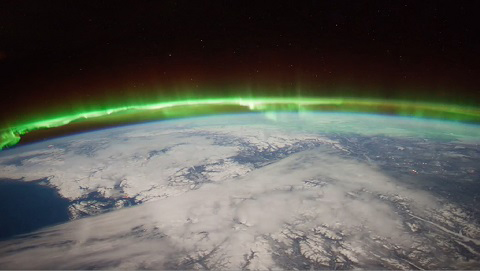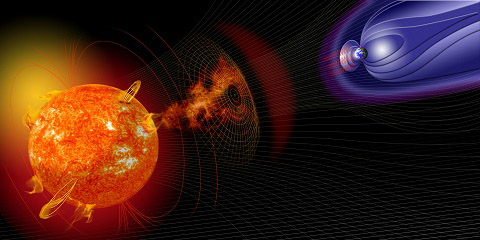Today the Anthropocene is everywhere. You may have encountered both scientific and non-scientific articles that begin with this geological greeting: “Welcome to the Anthropocene!” From a geological science perspective, planet Earth—and everything on it—is constantly moving along a timeline, from one distinctive era to another. In 2000, geologists Paul Crutzen and Eugene Stoermer proposed a new name for the current geological epoch: Anthropocene.[1] They argue that this term (which combines the Greek “human” + “new”) should replace ‘Holocene’ (“whole” + “new”) because it best describes an emerging geological condition. Human impact, they explain, is now a wholescale driver of Earthly environmental change.
For its many early adopters, the Anthropocene is a welcome scientific and political concept that expands understandings of human-Earth connections. Yet, while the Anthropocene concept is definitely planetary, I would suggest that it is not wholly Earth-bound. What does a closer examination of the term’s conceptual origins reveal about on-the-ground politics of spatial perception in the Anthropocene? Is there a paradox between the Anthropocene as an earthly timescale and geological entanglement with the planet’s own environment?

Image: Aurora lights result when energetic particles from the magnetosphere move into the ionosphere; ionospheric flux can interfere with electronic systems on Earth’s surface as well as in air and orbital spaces. Source: NASA, February 2012.
As the Anthropocene opens up questions about planet-scale concepts of time, it also opens up questions about planet-scale concepts of space and environment. In particular, the concept calls attention to sociocultural assumptions about human temporal and spatial wholes, boundaries, and differences. Scholars are already observing how the Anthropocene concept of “the human” can render socially invisible the wholly uneven planetary distributions of human environmental impact causes, effects, and responsibilities. But planet-scale holistic concepts like the Anthropocene are not hard bounded. They have broader connections to non-terrestrial and even non-planetary spaces in their genealogies, which, if ignored, can make scientific and political aspects of environmental boundary- and scale-making invisible.
Making the Anthropocene
Lisa Messeri and I recently examined the Anthropocene as a spatial concept-in-the-making [2]. It turns out that Earth’s Anthropocene era emerges from a more-than-Earthly political ecological space of science, technology, and environmental perception and activity. This space is extraterrestrial and expands throughout the solar system. The scope of that trans-Earthly space is even visible in Crutzen and Stoermer’s original Anthropocene article.
Although Crutzen and Stoermer’s inaugural paper about the Anthropocene aims to recharacterize the Earth’s geological inner space between surface and stratosphere, the authors right away gesture into outer space to define the kind of environmentally interactive human the Anthropocene concept references. They start their argument by noting that philologist and politician G.P. Marsh’s sentinel 1864 book about human transformations of natural spaces, originally entitled Man and Nature, has been reprinted and retitled as The Earth as Modified by Human Action. On the heels of this observation, they state that a spatially extreme example of such human geophysical modification occurred when “mankind” became able to “set foot on the moon.” [3] Crutzen and Stoermer go on to think with solar systemic objects to show how contemporary understandings of human/environment relations have progressed to broaden the scope and scale of human geophysical perception and modification. Later in the text, the authors name the outer space threat of asteroid impact as one among a list of global environmental crises that humans could avert in the Anthropocene by harnessing the unearthly immaterial “noosphere” of human consciousness as a problem-solving resource. Borrowing a term developed by Soviet geochemist Vladimir Vernadsky (1944) to describe how human cognition acts as a transformative geological force, Crutzen and Stoermer advocate that societies unite to “develop a world-wide accepted strategy leading to sustainability of ecosystems.” [4]
Drawing the Anthropocene’s boundaries: outer space becomes nature
In Crutzen and Stoermer’s article, the Anthropocene’s evidentiary space for the reach of human impact and the scope of human perception exceeds terrestrial geological ground. So, while outer space remains outside Earth, parts of it are provisionally connected to an Anthropocenic human and its geophysical environment.

Image: Artist illustration of events on the sun changing the conditions in Near-Earth space. Source: NASA/Department of Homeland Security Space Weather Twitter Chat
The ways that Crutzen and Stoermer both include and exclude extraterrestrial space in their argument calls attention to key spatial features of the Anthropocene, namely, the way the concept delineates strong terrestrial boundaries for geological and environmental science, with selective references to extraterrestrial space as a zone of geologically relevant extremes, backgrounded exceptions, or irrelevant inhuman otherness. Because Earth’s moon and solar systemic asteroids lie beyond the space in which human impact takes a central role, they are ecologically important to spatial conceptualizations of the planet’s environmental conditions but are mostly tangential to everyday environmental politics on Earth (unless they happen to hit the ground). This selective boundary-making draws people’s environmental attention downward and inward and provides new ways to naturalize terrestrial/extraterrestrial divisions. In effect, though the Anthropocene concept began with reference (albeit an uneasy one) to a physical environment that extends beyond and includes Earth, today’s scientific and social scientific theorizers of the Anthropocene can easily end up hermetically sealing Earth from its broader geophysical environment when writing about our geologic present.
Why do the Anthropocene’s different geological and conceptual spatial boundaries matter? Environmental dividing practices like this can block opportunities to critically assess the ways in which different governmental and corporate forms of solar system-scale sciences and technologies—such as astronomy, comparative planetology, and state and private space system projects—influence the development of Anthropocene-era concerns. These activities play crucial roles in how social groups imagine and compare planetary atmospheres, geological systems, habitability criteria, and exposure to solar system weather. Giving the Anthropocene a hard Earth-scale environmental boundary creates, in effect, an environment of The Environment. This other environment we call “outer space” is made to stand outside of an inner, terrestrial, post-natural human environment. It becomes, in effect, a new Nature: only partially connected to Earth and our life on it, an alien cosmic backdrop for terrestrial histories.
Footnotes
[1] Crutzen, Paul J., and Eugene F. Stoermer. 2000. “The ‘Anthropocene.’” International Geosphere–Biosphere Programme (IGBP) Newsletter. 41: 17–18.
[2] Olson, Valerie and Lisa Messeri. 2015 (forthcoming). “Beyond the Anthropocene: Un-Earthing an Epoch.” Environment and Society.
[3] Crutzen and Stoermer, 17.
[4] Cruzen and Stoermer, 18.
Valerie Olson is an Assistant Professor of Anthropology at the University of California, Irvine. She studies the making and governance of large scale environmental systems and extremities.

1 Comment
Thank you!
1 Trackback